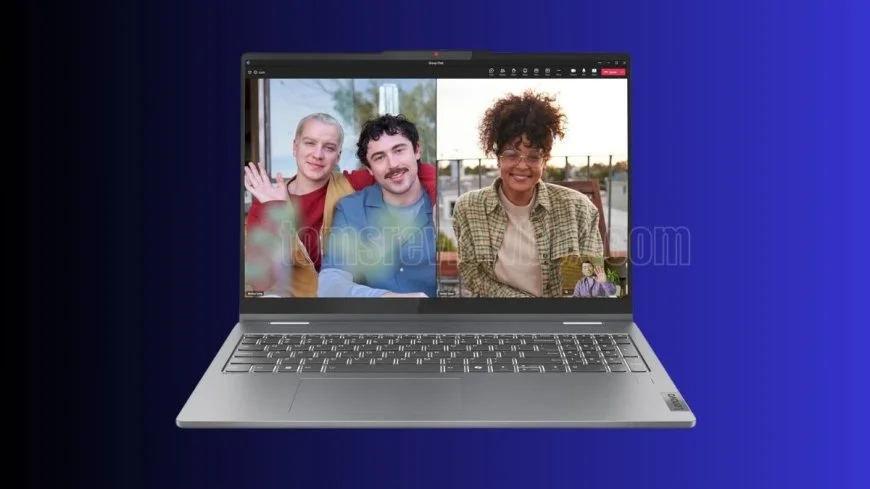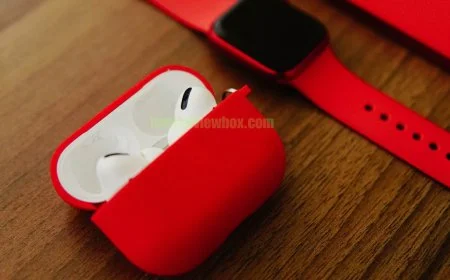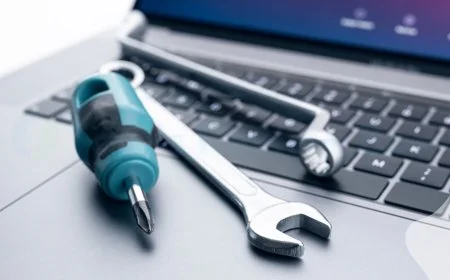How to enable the camera on your Lenovo laptop?
Learn how to enable the camera on your Lenovo laptop effortlessly with our step-by-step guide and troubleshooting tips.

You’re sitting in front of your Lenovo laptop, ready for a video call, but the camera just won’t cooperate. Annoying, no? Don't panic; we have your back.
We’ll show you exactly how to enable that pesky camera step by step. Other times it's as simple as a privacy setting blocking access or perhaps a software glitch. We’ve seen it all and know how to troubleshoot these common hiccups.
Follow along and you will be streaming in no time without having to drown in technical jargon.
Key Takeaways
-
Look in the settings under 'Device Manager' and ensure your Lenovo laptop's camera is enabled. If it’s not, update the camera driver to get it working.
-
Make sure no other applications are using the camera. Ensure the privacy settings allow the camera to be used.
-
Adjust your privacy settings by going to the Privacy section of your Windows settings. This will ensure that applications have the necessary permissions to access the camera.
-
To speed up a Lenovo laptop, remove startup programs and clean disk space regularly.
-
To address slow performance issues, begin by updating your operating system. Then, run a virus scan to get rid of any possible threats.
-
Regular maintenance, like clearing out temporary files and adjusting system settings, can improve laptop performance.
How to Enable Camera
1. Access Device Manager
The first thing you need to do is access my Device Manager, which serves as a mission control for all the gadgets connected to your laptop, including your integrated camera. If you’ve never been there, don’t worry; it’s quite simple. Let’s break it down: once you’re in, you have the keys to the kingdom, where you can troubleshoot camera settings and view everything attached to your laptop, from your keyboard to your webcam.
In this section, you can also check for any blurry webcam issues that might be affecting your video chatting experience. If you encounter problems, consider following additional troubleshooting steps to ensure that your camera image is clear. This can involve checking the camera indicator light and ensuring that the right permissions are granted for the applications you are using.
-
Click the Windows icon at the bottom left of your screen. Type “Device Manager” in the search bar and hit Enter. It’ll pop up right there.
-
If you’re old school, you can also go through the Control Panel. Open it, head to “Hardware and Sound,” and then click “Device Manager.
-
For those who love shortcuts, press the Windows key + X together, then choose “Device Manager” from the menu that appears.
To enhance your experience further, you may want to look into driver updates or firmware for your laptop. This can help resolve any configuration issues that might be causing problems with the camera function. Additionally, ensure that you have a strong internet connection, especially if you are using platforms like Microsoft Teams or Google Meet for video calls.
Lastly, if you continue to face issues, don’t hesitate to reach out to Lenovo service technicians for support. They can assist in diagnosing whether the cause is a hardware problem or something that can be fixed through software adjustments. Remember, keeping your device updated is essential for optimal performance and to avoid unnecessary complications.
2. Locate Camera Device
Now that you're in Device Manager, you need to locate the integrated camera. It's typically included under "Imaging Devices" or "Cameras." If you encounter blurry webcam issues, consider yourself a detective; these troubleshooting camera settings should help you find your missing camera.
-
Look for Imaging Devices: Scroll through the list on the left. Click on the little arrow next to “Imaging Devices” to expand it. Your camera should be listed there, as something like “Integrated Camera” or “USB Camera.”
-
Sometimes, the camera might hide under different sections like “Sound, video and game controllers.” Strange, but it happens.
-
If you can’t find it, click “View” in the top menu and select “Show hidden devices.” This might help you catch any camera that’s being coy.
-
If you’ve got a webcam plugged in, make sure it’s connected properly. It’ll typically appear under “Universal Serial Bus controllers” or “Cameras.”
To ensure proper functionality, check for any error messages related to the camera icon. If the camera indicator light isn't on, it might indicate a hardware problem. Remember, additional troubleshooting steps may involve updating drivers or checking privacy settings that could affect video chatting applications.
If you still can't find the camera, consider using the F8 key or a toggle button to enable it. In some cases, users have found that multiple reboots resolve the issue, so don't hesitate to try that. Following these guidelines can help you regain access to your camera for platforms like Microsoft Teams or Google Meet.
3. Enable Camera Hardware
Okay, you’ve located your integrated camera. Now let’s ensure it’s turned on and ready to roll for video chatting. The first thing you need to do is enable your camera hardware, as these troubleshooting camera settings ensure it’s not just sitting there in sleep mode.
Next, check the camera indicator light to confirm functionality. If the light isn’t on, it may indicate a hardware problem. Consider additional troubleshooting steps, such as verifying permissions within your applications, which can help resolve any configuration issues that might prevent the camera from functioning properly.
-
Right-click on the camera name. Then, if you see an option that says Enable device, click it. This means your camera was off, and this will wake it up.
-
Verify it’s enabled: If the option says “Disable device,” then it’s already on. You’re good to go.
-
If you can’t enable it, there might be a hardware issue. Check if there’s a tiny switch or button on your laptop that turns the camera on and off. Not all laptops have this, but some do.
-
Look for a function key on your keyboard, usually marked with a camera icon, that might toggle the camera on and off. Try pressing it together with the “Fn” key to see if that helps.
Lastly, if you continue to experience blurry webcam issues, you may want to adjust the camera settings or check for driver updates. Ensuring enough light in the area can also improve the camera image quality, enhancing your overall experience during video calls on platforms like Google Meet or Facebook Messenger.
4. Update Camera Drivers
If the camera doesn't remain functional, you may have to update its drivers. Drivers are like translators between your camera and laptop, and they need to be current.
Here’s the scoop on updating them:
-
Right-click your camera in Device Manager and select “Update driver.” Select “Search automatically for updated driver software.” Your laptop will then search and install any updates it finds.
-
If automatic doesn’t work, you might need to download the latest drivers from the Lenovo website. Type in your laptop model, locate the camera driver, download, and install.
-
Sometimes updates cause problems. If your camera isn’t working after an update, don’t panic! To roll back your driver, simply open Device Manager, right-click on your camera, select “Properties,” go to the “Driver” tab, and select “Roll Back Driver.”
-
Check Windows Update: Occasionally, drivers come through Windows Update. Keep your system up to date! Head over to “Settings,” choose “Update & Security,” and hit “Check for updates.”
Updating drivers makes sure that your camera operates without a hitch and remains compatible with your system.
It’s like a tune-up for your camera to keep it running at its best.
Troubleshoot Camera Issues
Identify Common Camera Problems
You’re ready for a video chat, excited to connect. Then, all of a sudden, your camera goes missing!
You’re not alone! Many people with Lenovo laptops have dealt with similar dilemmas. Let me break it down.
First, it’s important to realize there’s no one root cause of these problems. Sometimes, you have an issue with the settings of the program you’re using.
For example, Zoom or Skype may not be enabled to use your laptop camera at all. See that the app is actually designed to use the camera.
If your Lenovo laptop camera is working if you can see an image. If that’s the case, the problem is most likely with the software.
Remarkably, 80% of the time, it’s a software glitch, not the camera. So before you freak out, get into those app settings and see if it's all screwy.
Resolve Software Conflicts
Software conflicts, like uninvited party guests, crash the party. These conflicts can be a complete pain, especially when using applications like video chatting tools. Start by checking your Windows updates. Open Windows Update and install any available updates for both Windows and your drivers, as this usually fixes compatibility problems and can help with blurry webcam issues.
Sometimes, the problem may stem from a program that has frozen in place. If so, our guide on how to force-quit a program in Windows is a lifesaver. Let’s say you’re using an app, and it won’t close or respond — force quitting could be the magic trick to regain control.
Your Lenovo laptop's integrated camera should be detected by the app. If it doesn’t display a clear camera image, the issue may not lie with the camera itself. It could be related to the app or even permission issues. Restarting the app or switching to a different one might help resolve the problem.
In some cases, additional troubleshooting steps may be required to ensure your camera functions properly. If you notice a blurry webcam feed, adjusting the camera settings or ensuring there is enough light can significantly improve visibility.
Lastly, if the camera icon shows an error message, it may indicate a deeper hardware problem. In such instances, contacting Lenovo service technicians for further diagnosis could be the best course of action to resolve any camera issues effectively.
Check Hardware Connections
Now let’s get to the hardware. Though rare, sometimes the issue might be with the physical connections.
Your Lenovo laptop camera may appear as an Integrated Camera. Make sure it's active.
You can do this by opening the Device Manager. Simply search for “Device Manager,” look for your camera, right-click it, and see if it's enabled. If it isn’t, turn it on.
This simple action will probably fix the problem.
If you're using an external camera, make sure that it's plugged in tightly. Sometimes, it's the little things, such as a loose cable, that can cause big problems.
Do a once-over on everything to make sure all the connections are solid.
Adjust Privacy Settings
Access Privacy Settings
Okay, let's see if we can start off by going through the privacy settings on your Lenovo laptop.
Click on "Start" to begin. It's that little Windows icon in the bottom-left corner of your screen.
Then, once you're there, type "Settings" into the search box and hit enter. It’s easy, right?
Then, in the Settings window, keep an eye out for "Privacy" and send it a click. This is where all the magic happens.
On the left, there is a menu that you will see. Scroll down that list until you find “Camera,” and select it.
That’s essentially the command center for every camera-centric thing on your laptop.
If you ever feel lost, don’t worry! This is really your location for controlling your camera's privacy settings.
Modify App Permissions
Next, let's ensure that the right apps are allowed to use your camera.
Still in the Privacy settings under "Camera," you'll see a section called "Choose which apps can access your camera.
I can’t overstate how crucial this part is.
From there you’ll see a list of all the apps that could potentially access your camera.
Work your way through this one slowly. If you want a specific app to use the camera, simply toggle it to "On." If you see an app you don’t trust or don’t use much, switch it off.
That simple step keeps your device safe.
This allows only the apps you permit access to the camera.
If you're asking yourself why some apps may require this access, think video calls, taking photos, or even scanning documents.
Always double check this list if your camera isn’t working with a specific app.
Control Camera Access
Now, let’s discuss managing overall camera access on your Lenovo laptop.
Right above the list of apps, you’ll see a toggle that says Allow apps to access your camera.
This switch is like the master key. If you turn it to "Off," none of your apps have access to the camera. This restriction applies even if you configure individual permissions.
If your camera isn't working at all, check this first. It might be just the thing that solves your problem!
Turn it “On” to allow the camera for every app. It might concern some people about privacy, but I'd argue that you can simply turn the camera off when not using it. You can turn it back on very easily when you need to.
That way, you’re fully in control of when and how your camera gets used.
Improve Lenovo Laptop Speed
Identify Performance Bottlenecks
You’ve got to know what’s slowing your Lenovo down.
Think of it as hitting a jam in your traffic. You want to see where things are getting stuck.
Identify the problem first and then check your Task Manager on Windows or Activity Monitor on Mac. These display what uses the most resources — CPU, memory, disk space, etc.
Look for apps or processes that are hogging the power. It’s almost like discovering what’s gobbling up all your cookies.
You may find that some apps use up resources unnecessarily. For example, that fancy game or video editing software is chomping up a big chunk of your CPU.
It could also be background apps you don't even use. Ask yourself, “Do I really need these running all the time?
If not, close them to free up space. It’s an easy way to go a bit faster.
Another thing to check is your startup programs. These are the apps that open automatically when you power up your laptop.
Too many of these will slow your start-up time. You can manage these in the Task Manager and disable the ones you don’t need immediately.
It’s like tidying up your room so that you don’t trip over things every morning.
Optimize System Resources
Now, let's get into how to actually maximize your system's resources. It's like using every part of the buffalo.
You want the RAM and CPU in your laptop to be doing their best work. One way to do this is to tweak your power settings.
If you require more speed for your tasks, change your laptop to 'High Performance' mode. Remember, this will deplete your battery more quickly.
Next, consider your storage. If your hard drive is almost full, your laptop's going to slow down.
Now it’s time to do a little housekeeping. Delete files or apps you don't need, or move them to an external drive. You could also use cloud storage.
It’s like moving stuff to the attic when your closet is too full.
Consider upgrading your hardware. Adding more RAM or switching to a Solid State Drive (SSD) can make a huge difference. It's like swapping out the engines of your laptop.
If you don’t know how to do those things, get help from someone who has before.
Update Software and Drivers
It's important to keep software and drivers up to date, much like ensuring your car has the latest oil change. This includes checking for any necessary webcam driver updates to maintain optimal performance.
To begin with, visit Lenovo's official website. By entering your laptop's model number, you can download the most recent drivers, particularly for your integrated camera. You just want to ensure that everything is functioning smoothly.
Windows and macOS have built-in troubleshooters that can assist in diagnosing camera issues. These handy tools can identify and fix many common problems, including blurry webcam images. To look for issues with your equipment, be sure to utilize these resources.
Windows and macOS have built-in troubleshooters. These handy tools can find and fix many common problems. To look for problems with your equipment, use them.
If your troubles persist, consider rolling your camera driver back to a previous version. Many users have found that this troubleshooting step addresses their blurry webcam issues effectively.
If you’re still experiencing camera problems, check out other applications to see if they work properly. Apps like Google Meet might not have the same issues, providing a good example of how different applications can behave.
If your troubles persist, roll your camera driver back to a previous version. You may discover this addresses your issue. A lot of people have tried this trick, and it worked for them.
For additional troubleshooting steps, ensure that you have enough light during video chatting sessions. A strong internet connection can also improve the overall visibility and quality of your camera image.
In summary, keeping your camera settings and software updated is essential for avoiding issues. By following these guidelines, you can enhance your video experience on platforms like Microsoft Teams or Facebook Messenger.
Solutions for Slow Lenovo Laptops
Detect Slow Performance Causes
When your Lenovo laptop starts lagging, it’s crucial to pinpoint what’s causing the slowdown. That way, you can deal directly with the problem.
Common culprits include needless startup programs, outdated drivers, and software bloat.
Look for these by opening the Task Manager. You can do this by pressing Ctrl + Shift + Esc.
When you get there, examine the Startup tab. It shows you what programs start when your laptop boots up. Disable the ones you don’t need.
In addition, look for high CPU or memory usage under the Processes tab. If something's consuming too many resources, it may need updating or reinstalling.
Another thing to watch out for is malware or viruses. They can sneak in and slow everything down.
Run an up-to-date antivirus software to scan your computer. Free options such as Avast or Bitdefender are good for this.
If your laptop’s still slow, check the hard drive. Hard drives can also develop bad sectors which affect speed.
You can run a disk check by typing chkdsk /f in Command Prompt. This will find and fix issues on your drive.
Implement Speed Enhancement Tips
You don’t always need to be tech-savvy to speed up your Lenovo.
First, get some room on your hard drive. Delete files you no longer need and uninstall programs you don’t use.
You can also use built-in tools like Disk Cleanup to clear out temporary files. Simply type “Disk Cleanup” in the search bar and follow the prompts.
It’s a fast way to supercharge your laptop.
There’s another trick, too, and that’s adjusting your laptop’s power settings.
On Windows, you select a high-performance plan that saves less energy but provides more speed. Go to Control Panel > Hardware and Sound > Power Options, and select High performance.
If your laptop has a solid-state drive (SSD), ensure it’s set as the primary boot drive. SSDs are far quicker than traditional hard drives. You can check this in the BIOS settings.
Think about upgrading your hardware. Adding more RAM or switching to an SSD does make a big difference.
RAM is your laptop’s short-term memory. More RAM lets your laptop handle more tasks at once. If you're not sure how to upgrade, many online guides will walk you through it step by step.
Regular Maintenance Practices
Keeping your Lenovo laptop running smoothly over time requires regular maintenance.
First, update your software and drivers often. Windows Update is your friend here. It not only updates Windows itself, but it also finds the latest drivers for your hardware.
Just to make sure it’s working, go to Settings > Update & Security > Windows Update.
Cleaning your laptop’s physical components is important too. As dust builds up inside, it can cause the laptop to overheat, slowing performance.
Use a can of compressed air to blow out dust from vents and the keyboard. Be gentle, so you don't break anything.
Check your laptop’s battery health, too. A failing battery can lead to performance issues.
Windows has a built-in battery report tool. Open Command Prompt and type powercfg /batteryreport to create a report. It’ll provide insight into the health of your battery and how it’s being used. If it isn’t holding a charge well, you may need a replacement.
Conclusion
Now you have the information you need to get that Lenovo camera going.
Easy steps? Check. Troubleshooting tips? Check again.
It’s all about knowing what to click and what to tweak.
Now you can take a picture or get on a video call without any issues.
If your laptop’s feeling a little sluggish, those speed tips are your new BFFs.
Don’t just stop here.
To prepare for launch, dive in, try things out, and make sure everything works just how you like it.
If issues arise, you’ve got the expertise to do something about it.
So, take it upon yourself, take charge, and make the most of Lenovo.
You got this!
Need some additional guidance?
Keep digging and get the answers.
Happy exploring!
Frequently Asked Questions
How do I enable the camera on my Lenovo laptop?
Press the F8 + Fn keys to enable the integrated camera. If you encounter blurry webcam issues, check the camera settings in the "Device Manager" under "Imaging Devices" for additional troubleshooting steps.
Why isn't my Lenovo laptop camera working?
Ensure that your privacy settings allow the camera to function properly by navigating to Settings > Privacy > Camera and toggling it on. For additional troubleshooting steps, update your camera driver via "Device Manager.
How can I adjust camera privacy settings on Lenovo?
Open "Settings," then "Privacy." Click "Camera," and scroll through to troubleshoot camera settings by toggling permissions for apps, controlling which applications can access your integrated camera.
What should I do if my Lenovo camera is blurry?
Gently clean the lens with a microfiber cloth, and ensure your room has enough light for better video quality. Additionally, check the camera settings to troubleshoot any blurry webcam issues.
How can I improve my Lenovo laptop's speed?
Regularly clear cache and temporary files, and consider uninstalling unnecessary applications. Additionally, disable startup programs through "Task Manager" for improved performance and faster boot times.
Why is my Lenovo laptop slow?
To troubleshoot performance issues, look for background processes using up resources, run "Disk Cleanup," and update your system and drivers to the latest version for optimal function.
How do I fix a slow Lenovo laptop?
Upgrade RAM and switch to an SSD for faster performance, while ensuring your antivirus program is updated and runs regular scans to prevent malware from causing slow internet issues on your device.
What's Your Reaction?







































![MacBook Pro M5: All the features and specs you need to know [LEAKS REVEALED]](https://tomsreviewbox.com/uploads/images/202502/image_430x256_67bd6d7cd7562.jpg)



























